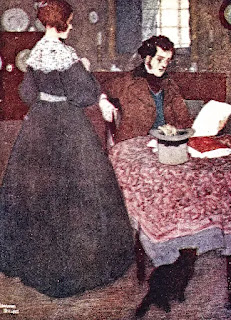Dawn Robey, a former Brussels Brontë Group committee member who now lives in France, returned to Brussels to give a talk to the group on ‘Interior Design in Charlotte Brontë’s “Belgian novels” – The Professor and Villette. In her presentation on Saturday 11 February 2023, Dawn explained how Charlotte uses descriptions of rooms to provide insights into the characters with whom they are associated.
Through readings and commentary on numerous extracts from The Professor and Villette, Dawn highlighted the details in Charlotte’s descriptions of settings that give clues to character – contrasting, for example, the glitter and gilt of Zoraïde Reuter’s parlour with Frances Henri’s much plainer lodgings.
One of the first interiors that Dawn discussed was William Crimsworth’s room when he arrives at the school in Brussels in The Professor. The chamber has practical and moral aspects, with the most notable feature being a boarded-up window. Crimsworth’s chamber is “a very small room with an excessively small bed. Yet though being so limited in dimensions, it has two windows … one of those windows was boarded up.”
Dawn explained that Monsieur Pelet, the headmaster of the boys’ school, indicates that “propriety” requires the boarding up of the window, which otherwise afforded a view into the garden of the girls’ school next door. Crimsworth is disappointed not have the chance to study “female character in a variety of phases, myself the while sheltered from view by a modest muslin curtain.”
 |
| Dawn Robey |
And thus begins the theme of surveillance and spying that runs throughout The Professor and Villette. Dawn explained how interior design elements – such as mirrors, lace-curtained windows and glass doors – accommodate such surveillance, and they come up again and again in Charlotte’s descriptions of the interior settings of her novels.
Dawn quoted Heather Glen in the introduction to the 1989 Penguin Classics edition of The Professor: “Charlotte Brontë’s carefully constructed prose … charts a pervasive process … of constant mutual surveillance.”
Charlotte also uses her descriptions of interiors to highlight the differences between her characters. Inside Mademoiselle Reuter’s pensionnat, there is “a passage paved alternately with black and white marble; the walls were painted in imitation of marble also; and at the far end opened a glass door.” The furnishings include many other lustrous items – a highly varnished floor, gilt frames, a porcelain stove.
 |
| The Professor |
Frances dislikes Mademoiselle Reuter’s surveillance methods, saying the school “is a building with porous walls, a hollow floor, a false ceiling, every room … has eye-holes and ear-holes ...”
The spying continues in Villette. “Surveillance, espionage — these were her watchwords,” Lucy says of Madame Beck. And she notes “a clear little oval mirror fixed in the side of the window recess – by the aid of which reflector, madame often secretly spied persons walking in the garden below.”
Details such as these show how Charlotte Brontë used vibrant descriptions of domestic interiors and the objects in them to illuminate the personalities of her characters. But Dawn said these can play an active role in the plot, too.
In Villette, arguably the most important interior is that of La Terrasse, the home of Dr. John and his mother, Mrs. Bretton. When Lucy goes there, all the furnishings seem strange and unfamiliar. But she slowly realizes that the Brettons, although displaced to the Continent, still carry on their lives as they did in England 10 years earlier.
Lucy says: “Tea stood ready on the table – an English tea, whereof the whole shining service glanced at me familiarly; from the solid, silver urn, of antique pattern, and the massive pot of the same metal, to the thin porcelain cups, dark with purple and gilding. I knew the very seed-cake of peculiar form, baked in a peculiar mould, which had always had a place on the tea-table at Bretton. Graham liked it …”
No comments:
Post a Comment